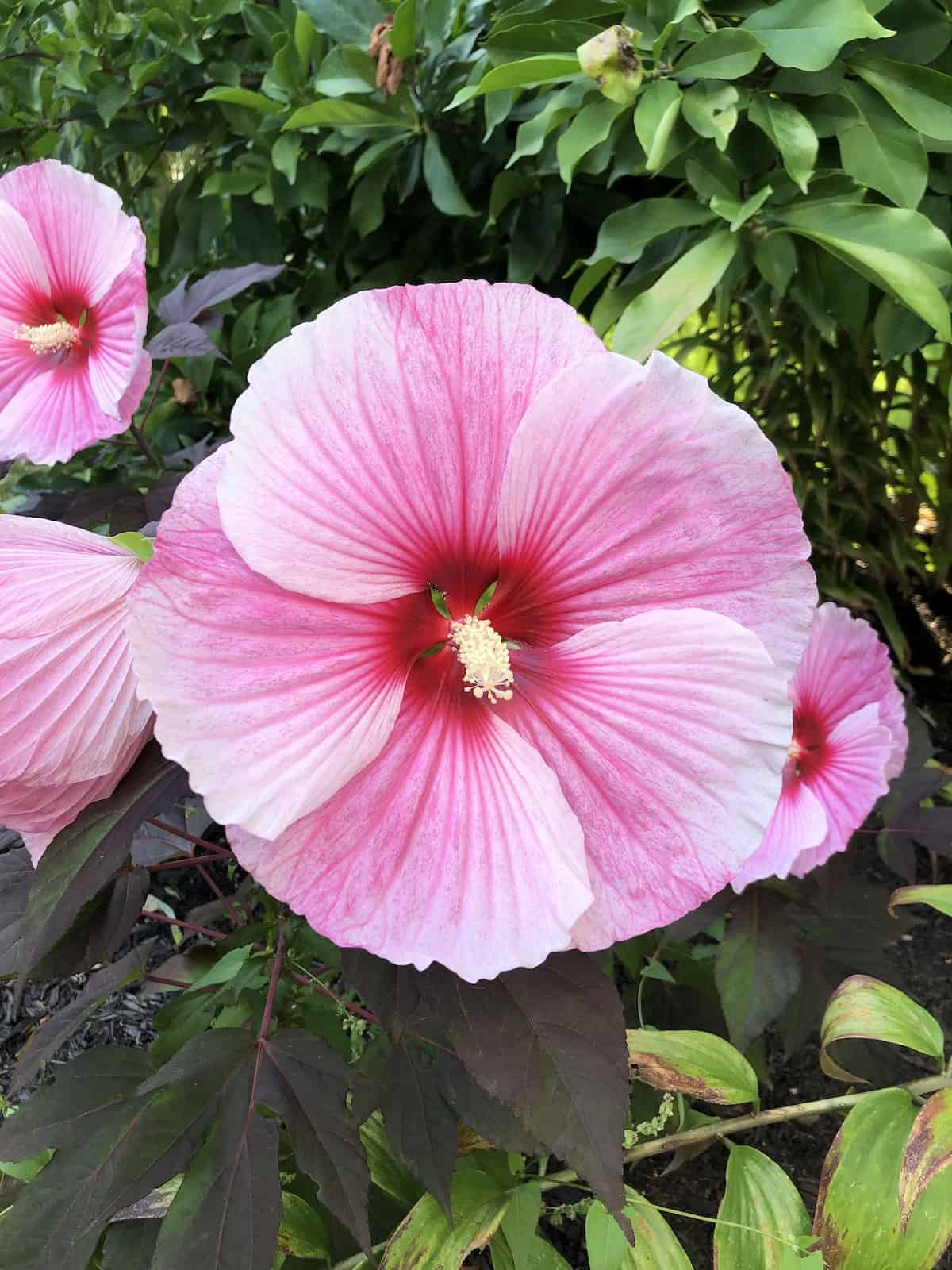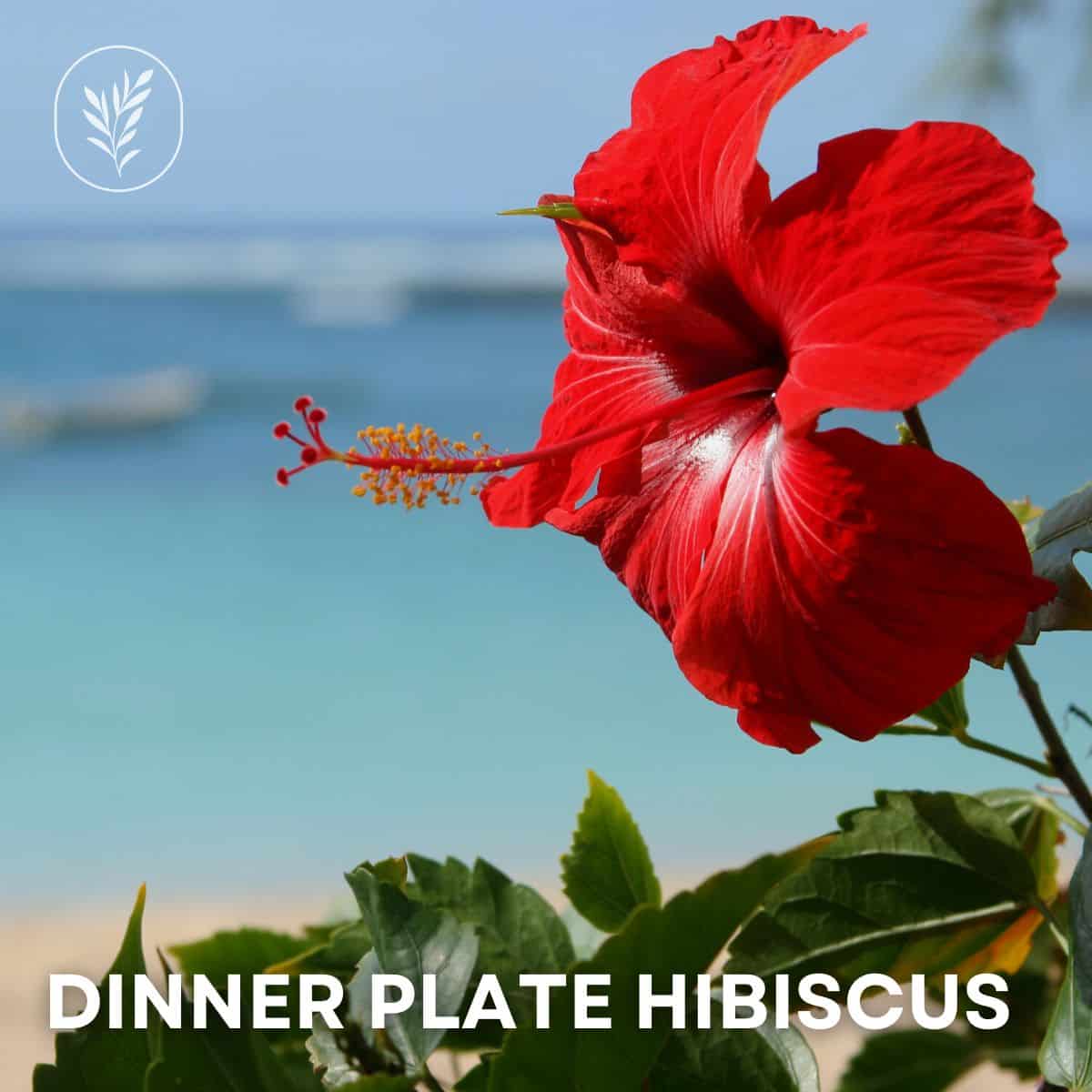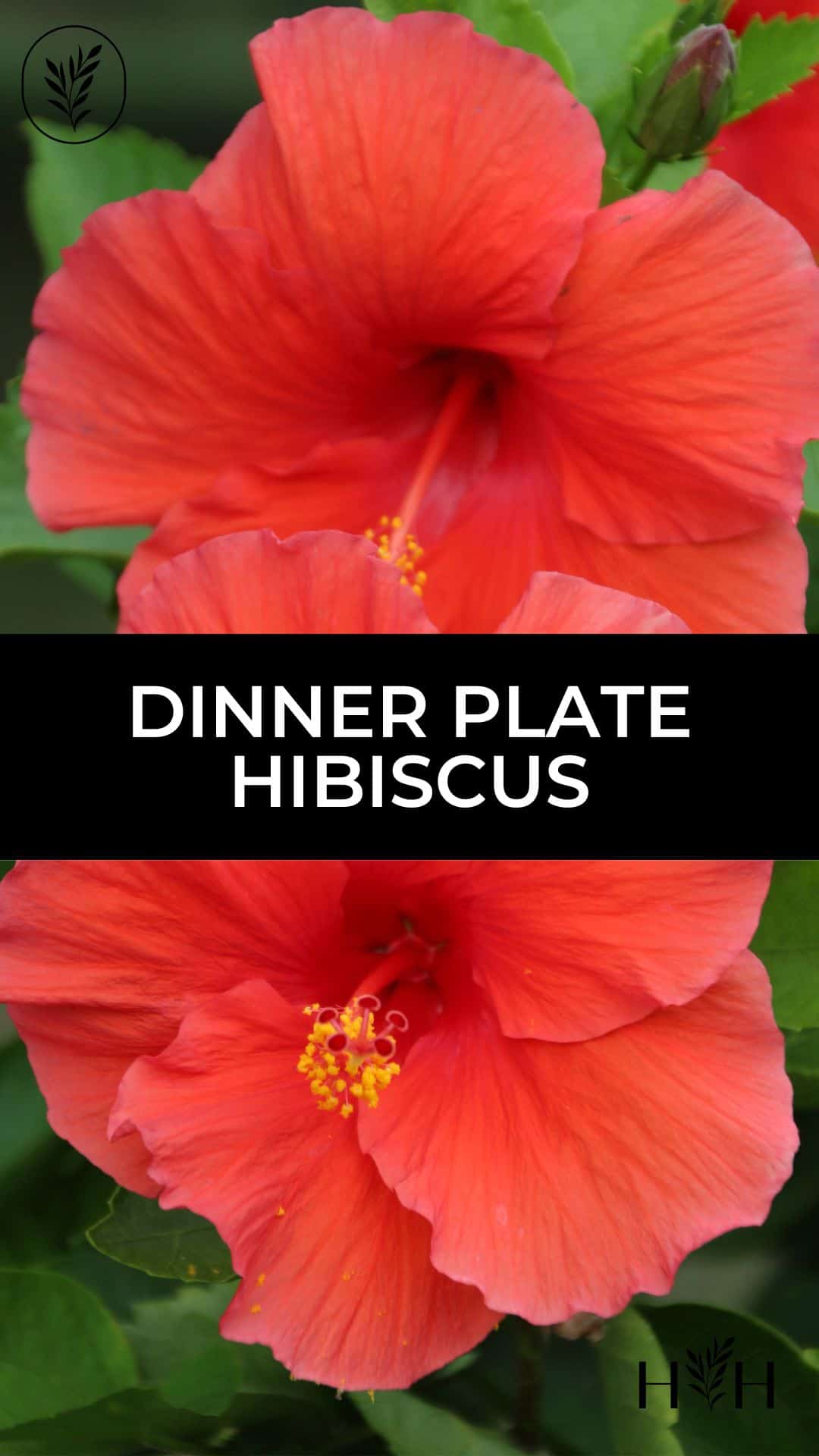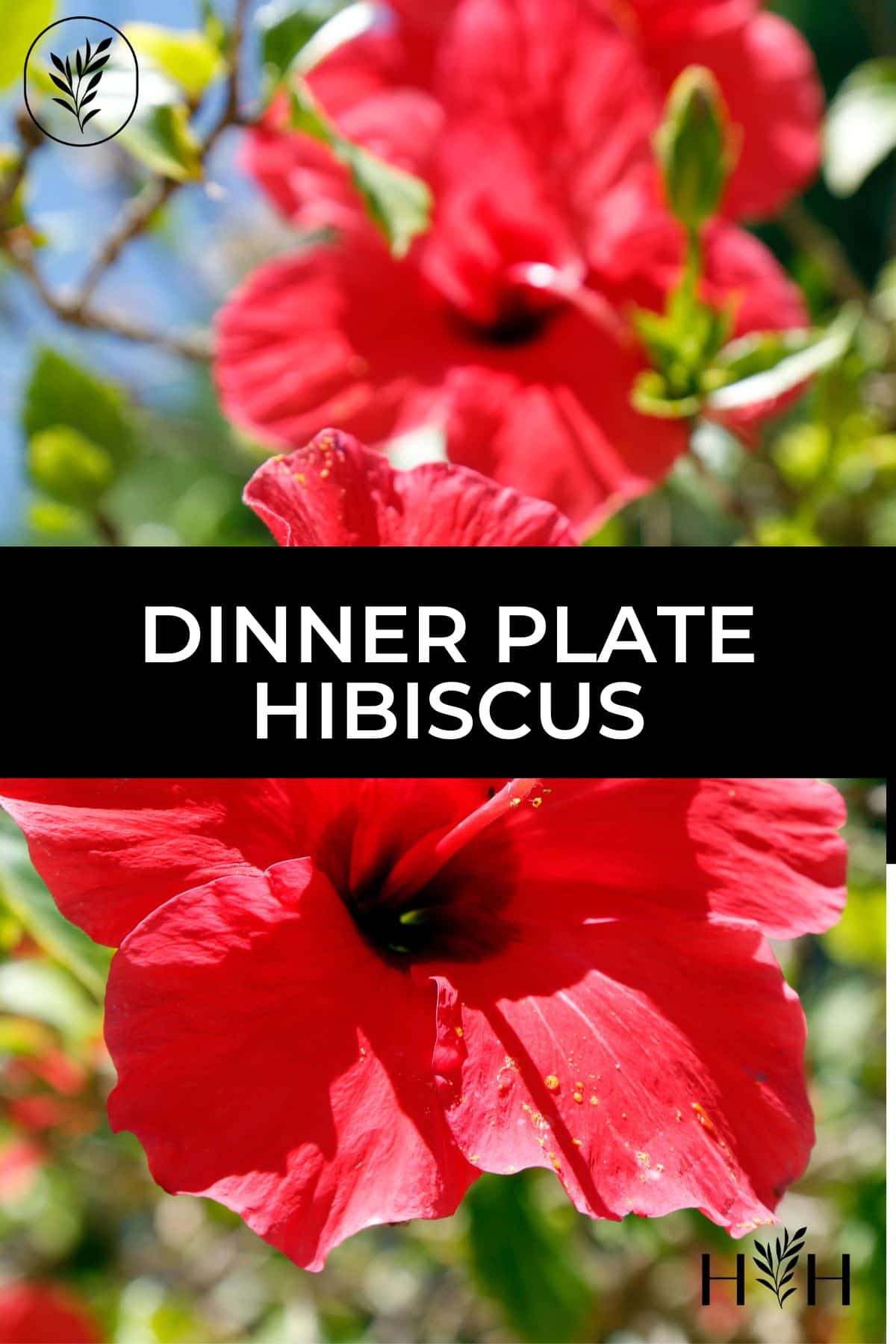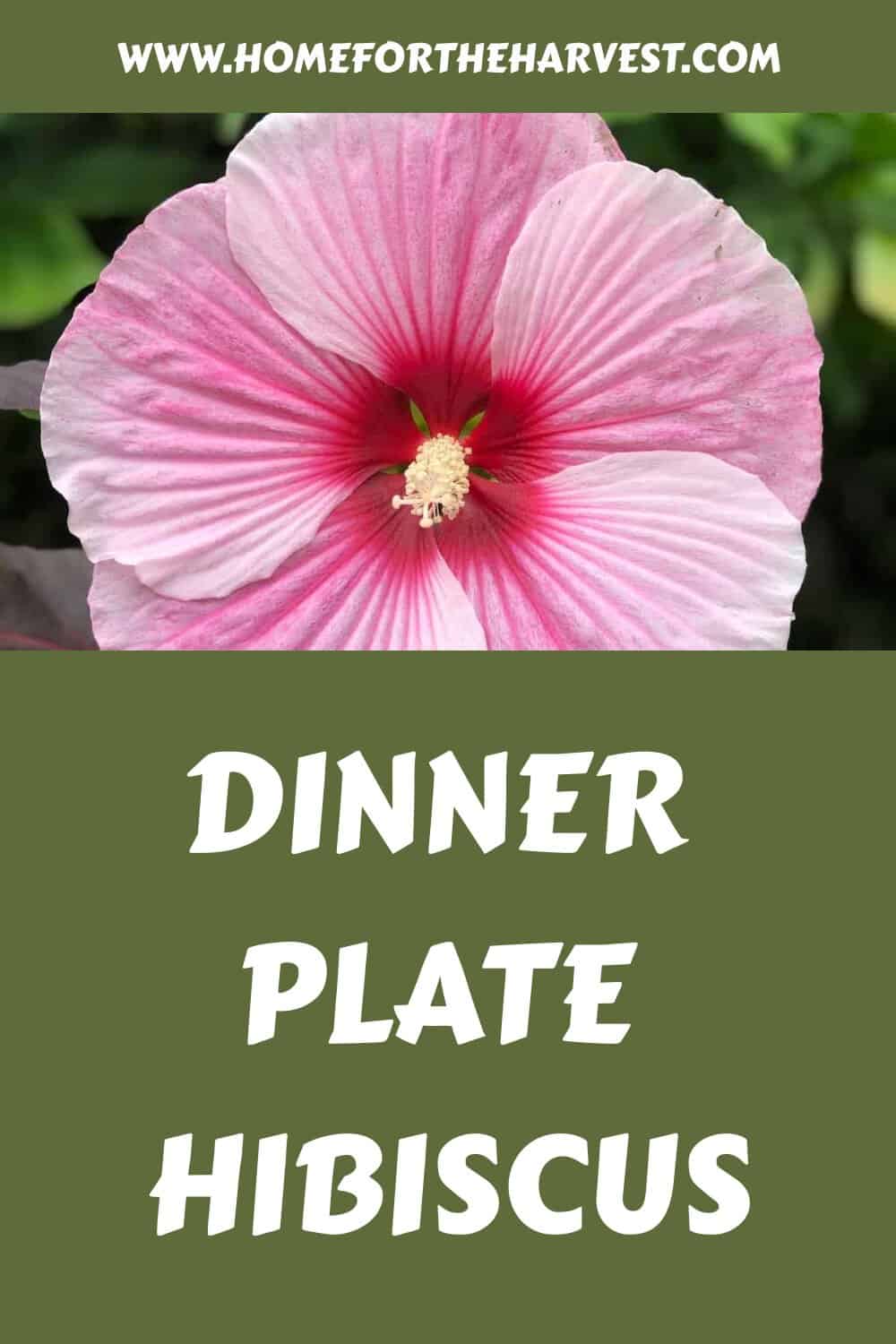Dinner plate hibiscus (Hibiscus moscheutos) is a cold-hardy, herbaceous, flowering perennial plant known for its giant, show-stopping blooms. Fresh stems sprout from the ground in late spring, quickly creating a small rounded shrub. The plant then blooms in late summer with huge, 8″-12″ wide blossoms in pink, white, or red. Native to the USA, dinner plate hibiscus plants are hardy in Zones 4-9, meaning they can be grown from Minnesota to Florida!
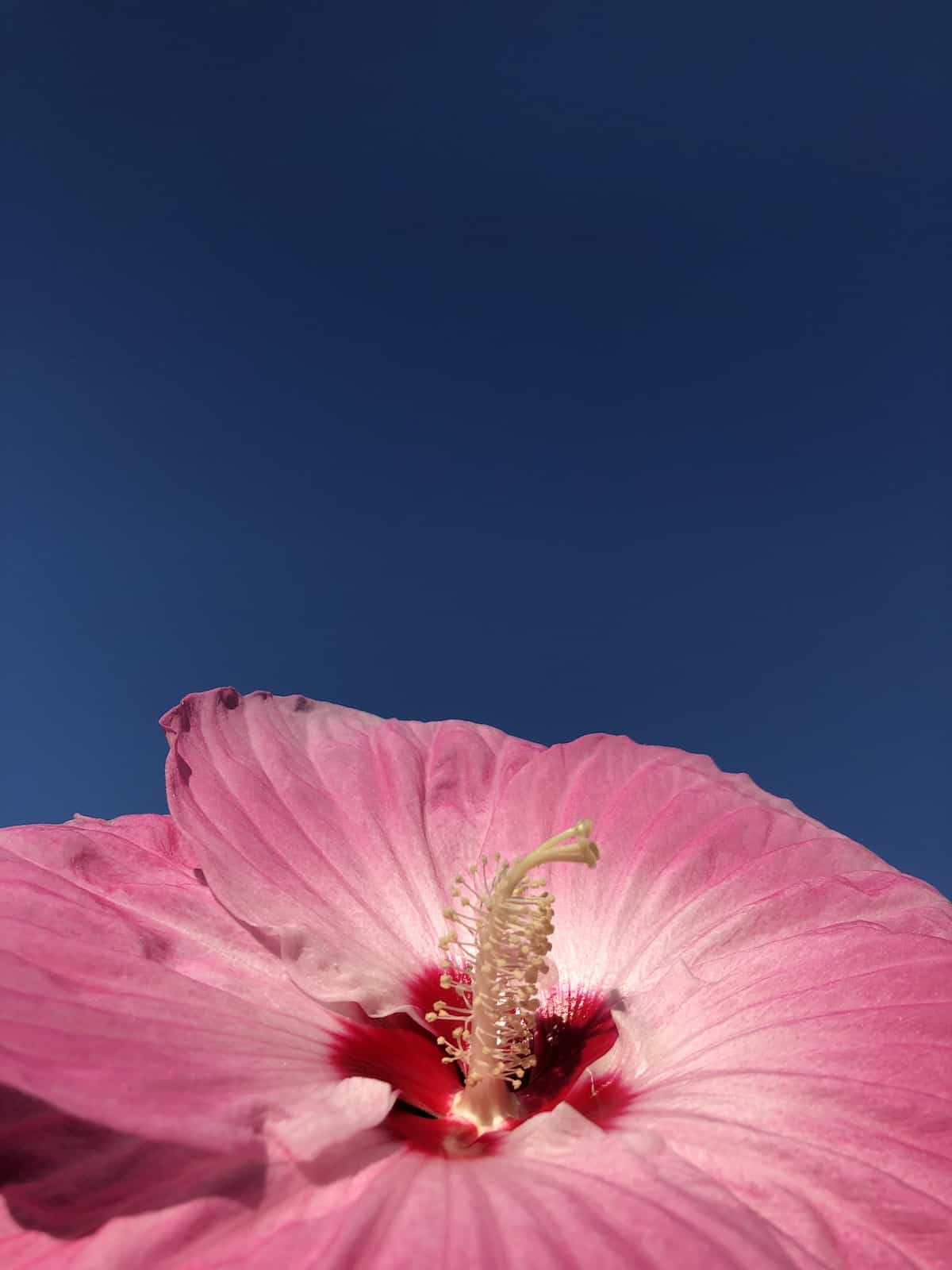
Dinner plate hardy hibiscus basics
Dinner plate hibiscus is also called hardy hibiscus, perennial hibiscus, herbaceous hibiscus, giant hibiscus, rose mallow, and swamp rose mallow. The Latin name for dinner plate hibiscus is Hibiscus moscheutos, part of the mallow family Malvaceae. Dinner plate hibiscus is a herbaceous flowering perennial plant.
Dinner plate hibiscus plants are native to eastern North America. They’re now available in wonderful shades, from the vibrant coral of the Mars Madness Hardy Hibiscus to the giant ombre pink blossoms of the Starry Night Hardy Hibiscus and the true regal purple of Plum Flambe Hibiscus! There’s a whole list of different cultivars/types of dinner plate hibiscus below.
Hibiscus moscheutos, commonly known as hardy hibiscus or swamp rose mallow, is a vigorous, sturdy, rounded, somewhat shrubby, hairy-stemmed, woody-based perennial of the mallow family. It typically grows to 3-7’ tall and to 2-4’ wide. It is native to wet spots (marshes, swamps, floodplains, river banks, moist meadows, and moist woods) from Ontario and Massachusetts south to Ohio, Indiana, Alabama and Florida.
Hibiscus moscheutos, Missouri Botanical Garden
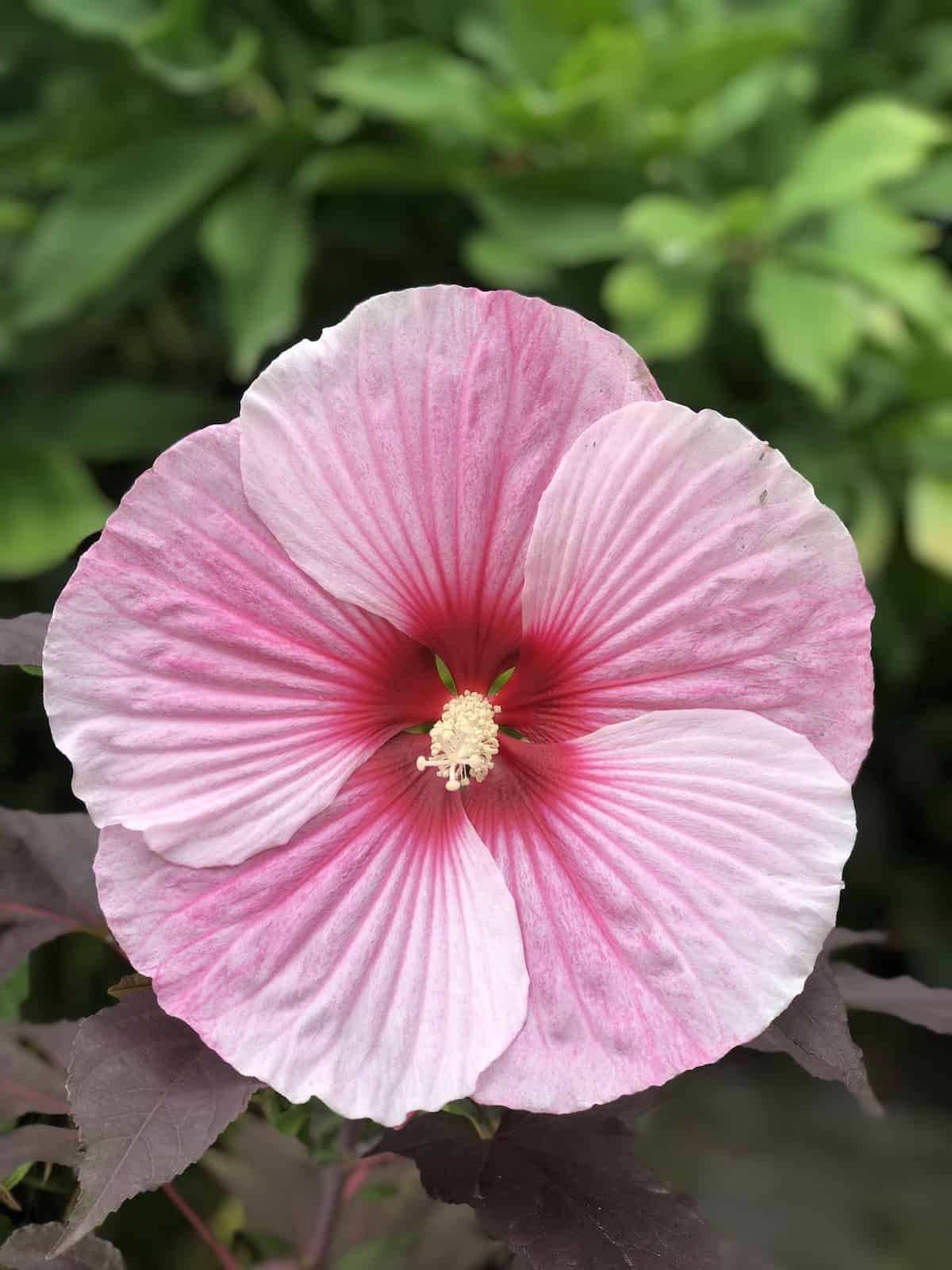
Hardy dinner plate hibiscus plants
Hibiscus moscheutos is a herbaceous perennial plant, meaning that the foliage dies back to the ground each fall, and then sprouts fresh new shoots the following spring. Hardy dinner plate hibiscus plants are one of the very last herbaceous perennials to break dormancy and sprout up in the spring. In my Zone 5 garden, the first signs of new growth are often not until the end of May (or even early June). Small cultivars tend to create a ~3′ wide shrub in the garden while larger varieties can be more like 4′-5′ across (or more when well established).
The foliage on these plants is typically a rich green, a dark purple, or a mixed green-burgundy color. Most older dinner plate hibiscus cultivars have green foliage but many modern cultivars do have deep purple or nearly black foliage. The varieties with dark purple leaves are becoming more popular as gardeners look to add more depth of tone to their perennial garden beds. While older varieties tend to be quite tall and leggy, modern hybrid introductions (see list below) tend to form compact dense shrubs that are easier to fit into garden beds.
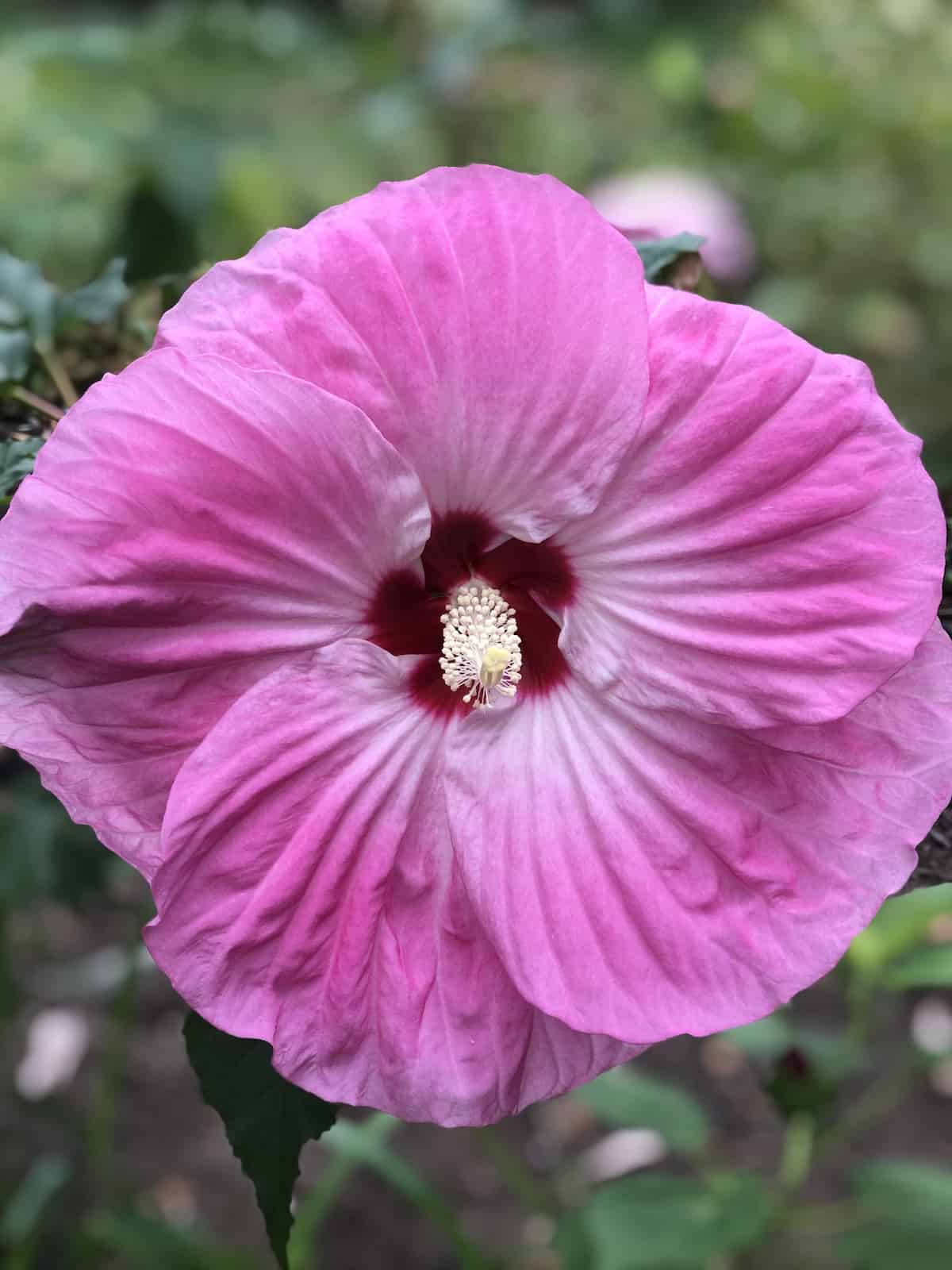
Dinner plate hibiscus plants
Dinner Plate Hibiscus is almost always grown for its very showy large flowers. They look tropical, even though they’re hardy to frosty, snow-covered Zone 4! Hibiscus moscheutos typically flowers from July-September with the majority of the flowers blooming in August. Each flower only lasts for a couple of days, but a single plant produces dozens of flowers. Even the flower buds are highly ornamental, forming pretty geometric buds in groups along or atop strong stems.
Like tomatoes, Hibiscus moscheutos plants are either determinate or indeterminate. Determinate varieties tend to be shorter and grow their flowers in clumps at the end of each stem. These plants have a short but very showy bloom period. Indeterminate varieties produce flowers along their stems as they grow. These varieties bloom over a longer period of time, but the blooms are not always at the top of the plant.
Dinner Plate Hibiscus flowers are very attractive to pollinators. The red and pink varieties are considered hummingbird flowers, since they act as a magnet for hummingbirds, who will trek your garden from all over the neighborhood to visit hardy hibiscus flowers. They are also attracted to the varieties with a red eye in the center of billowing white petals.
“Its flowers span up to 12 inches wide, beckoning fliers of all types, and last from early summer until the first frost. Plant this stunner in rich, moist soil in a sunny site.”
Gardening for Birds, Butterflies, and Bees: Everything you Need to Know to Create a Wildlife Habitat in your Backyard, by the Editors of Birds & Blooms Magazine
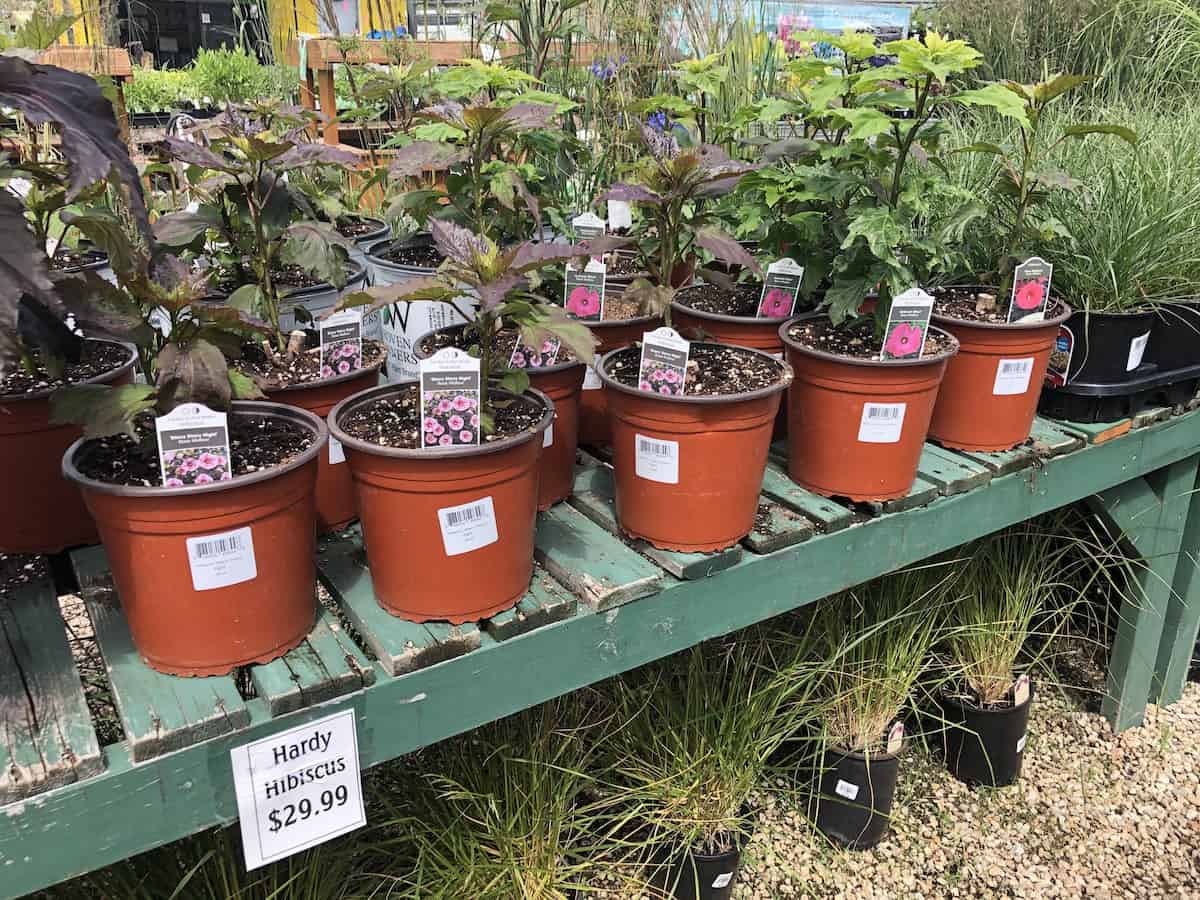
Planting dinner plate hardy hibiscus (Hibiscus moscheutos)
Here are the basics for planting dinner plate hardy hibiscus plants:
- Choose a site with full sun (at least 6 hours of direct sunlight per day).
- Choose a site somewhat protected from wind.
- Choose rich soil high in organic matter when possible.
- Choose soil that is naturally moist or easily watered on a frequent basis.
- Dig a planting hole 2x as wide as pot, but no deeper.
- Align the plant’s soil level with the level with the surrounding soil.
- Feed with a top dressing of homemade compost or organic fertilizer.
- Cover the surrounding soil with organic mulch.
Here is a video I made about planting hardy dinner plate hibiscus in the garden:
…Now I can’t wait for these new-to-me varieties to bloom!
Growing & caring for dinner plate hardy hibiscus (Hibiscus moscheutos)
Here are the basics for growing and caring for dinner plate perennial hibiscus plants:
- Spring shoots are slow to break dormancy and emerge. It may take until June to see them sprout up from the ground.
- Once new growth appears, the plants grow rapidly (assuming they have enough sunlight and water). The stems can grow an inch per day in good conditions!
- Ensure moist soil throughout the summer. The ground should be consistently damp, not soggy or dry.
- Dinner Plate Hardy Hibiscus tends to start blooming in midsummer. Blooming often starts in July with peak season in August. Some plants flower into early fall.
- Plants that aren’t flowering well may need more sun. Hibiscus moscheutos is quite heat tolerant as long as the roots have access to enough water.
- Deadheading spent blooms is common. Use clean sharp shears to trim off the crepe-like dead flowers.
- Cut stems down to about 6″ long in late fall (after frost) or in early spring.
Watering dinner plate hibiscus plants
Dinner Plate Hibiscus plants grow naturally in swampy wetland environments. Ensure that these plants have access to enough water, especially during dry spells in the summertime. Plants experiencing drought often drop their flower buds and lower leaves, leading to fewer flowers and less capacity for photosynthesis.
Frequent, consistent watering applies whether the Dinner Plate Hardy Hibiscus plants are in sandy loam soil or heavy clay soil. They will likely require more frequent watering than most other perennials in the garden. A drip irrigation system covered with organic mulch is recommended.
Pruning dinner plate hardy hibiscus
Dinner Plate Hardy Hibiscus plants rarely need pruning. These perennials are herbaceous, meaning the aboveground foliage dies back to the soil line each winter and sprout new stems in the spring. Pruning of this plant mainly consists of deadheading spent blooms in August-October. Snip the flowers off after each one has finished blooming to encourage the plant to continue putting on more flower buds. Avoid pruning any stems, as the flowers appear at the terminal end of each stem.
Fertilizer for dinner plate hardy hibiscus
Dinner Plate Hardy Hibiscus plants are generally fed once in the spring and again right before blooming. In the springtime, apply a slow-release organic granular fertilizer like Espoma Organics Plant-Tone or Dr. Earth Flower Girl Organic Fertilizer. If desired, you can give the plant a nutrient boost in the summer with a quick-acting water-soluble fertilizer as it starts to set flower buds before blooming. High-quality options include AgroThrive Fruit & Flower and Kellogg Organics Kelp & Fish Fertilizer.
Cutting back dinner plate hardy hibiscus
Dinner Plate Hardy Hibiscus plants are generally cut back to within 6″ of the soil line in either late fall or early spring. The timing of cutting back the flowers depends both on the gardener’s preference and the local climate conditions.
Some gardeners like to “clean up” their perennials and cut them back in the fall for a well-kept appearance during the winter. Others leave hibiscus stems on the plant to provide a habitat for overwintering insects and to prevent excess moisture from entering the hollow stems of the plant (as the stems can channel water down into the crown and encourage rot).
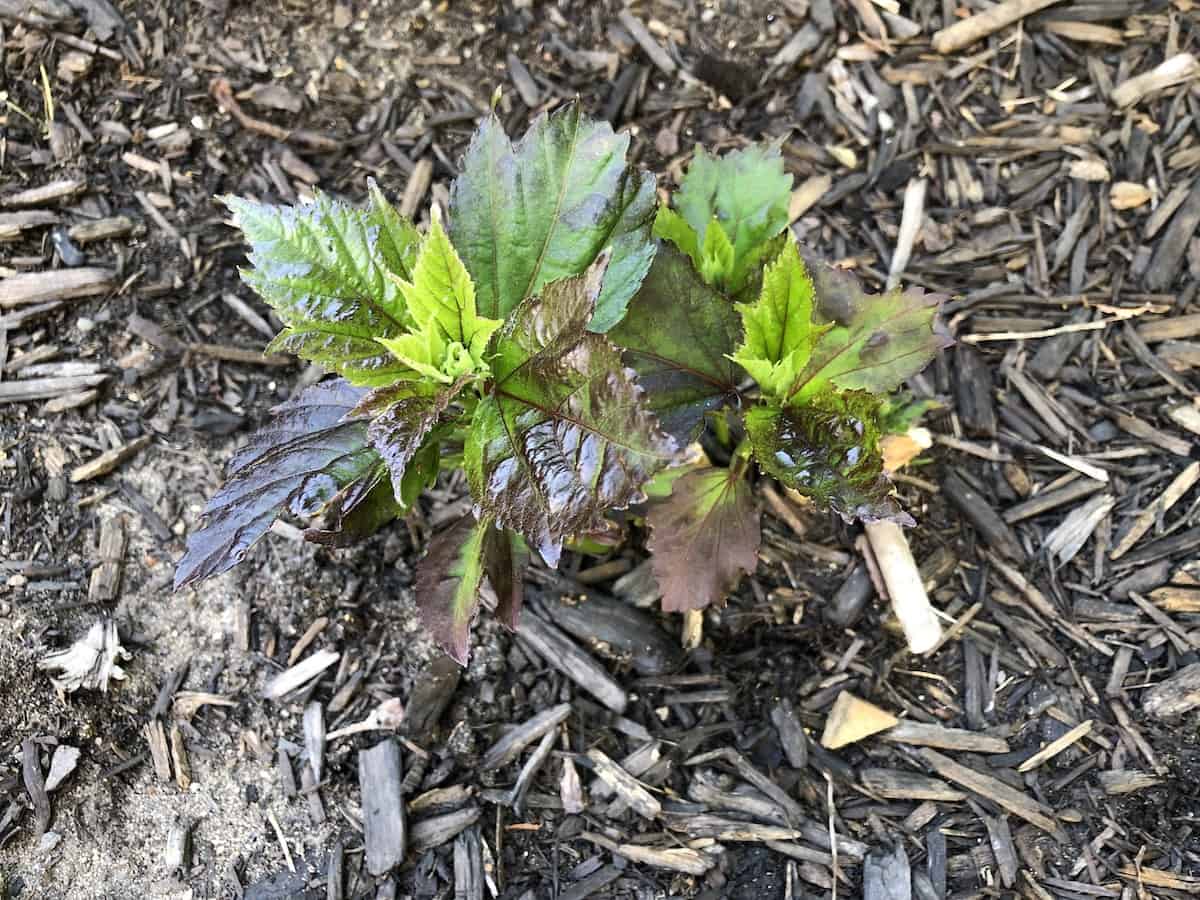
Common plant diseases affecting dinner plate hardy hibiscus
There are a few plant diseases that are common to Dinner Plate Hardy Hibiscus plants.
Crown rot is common in environments with wet winters and frequent freeze-thaw cycles during the shoulder seasons. Gardeners in these areas may wish to leave the stems on the plant until spring to provide a bit of a barrier to shed water away from the base of the plant.
During the growing season, issues like leaf spot, blight, and rust can affect Dinner Plate Hibiscus plants. Basic preventative measures include checking the plant frequently for overall health and to look for signs of disease, as well as supporting the plant by providing an optimal environment, including a full sun planting location, ample water, and good air circulation. If disease is suspected, apply an organic fungicide spray or another control to the plant at the frequency recommended on the product you choose.
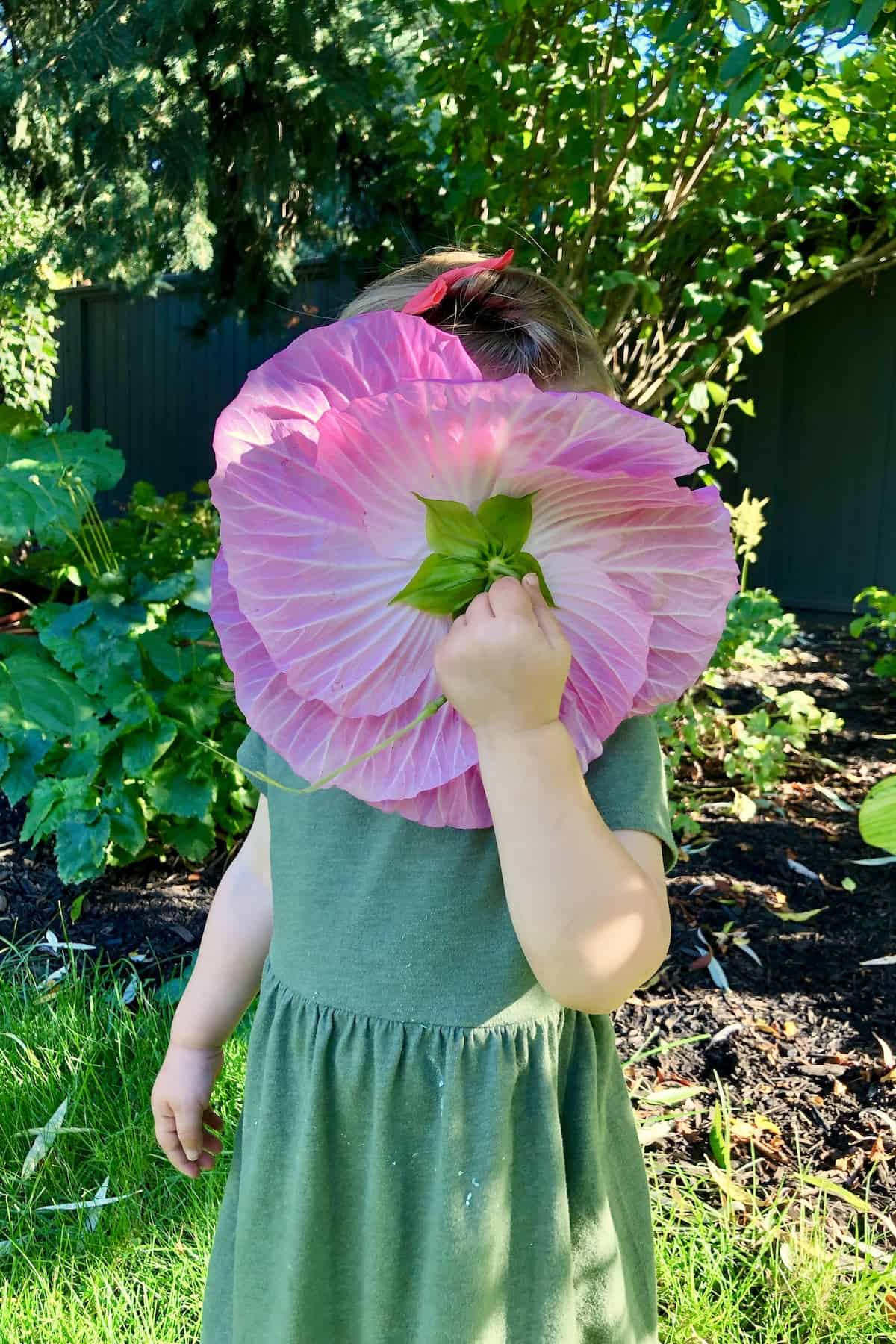
Dinner plate hardy hibiscus varieties
Here are some of the more common types of dinner plate hibiscus grown in home gardens. Many are available both from local nurseries/garden centers and from online plant sellers/nurseries.
Summerific® by Proven Winners’ Rose Mallow (dinner plate hibiscus)
- Evening Rose (hot pink)
- Candy Crush (hot pink)
- Berry Awesome (fuchsia)
- Spinderella (pink and white)
- Cherry Choco Latte (pink and white)
- Perfect Storm (white with soft pink)
- Holy Grail (red)
- Cranberry Crush (red)
- Ballet Slippers (white)
- French Vanilla (white)
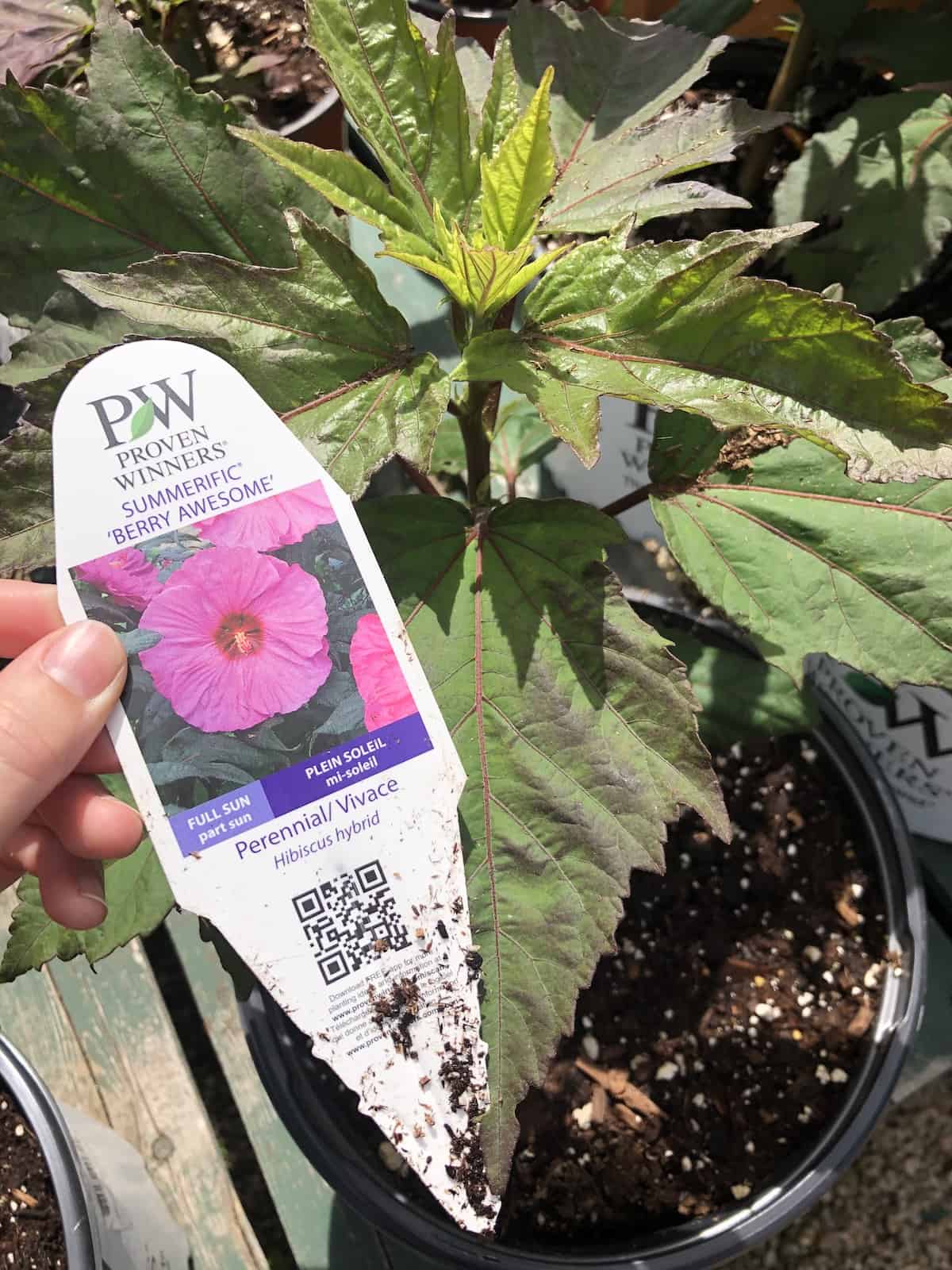
Summer Spice® Series of Hardy Hibiscus
- Bleu Brûlée (blue)
- Plum Flambe (purple)
- Cordon Bleu (blue)
- Ambrosia (hot pink)
- Amaretto (pink)
- Crepe Suzette (hot pink)
Head Over Heels® Series Hibiscus
- Head Over Heels® Blush Hibiscus (pink and white, ruffled)
- Head Over Heels® Passion Hibiscus (hot pink)
Luna Series of Hardy Hibiscus
- Luna Pink Swirl (pink and white)
- Luna Red/Luna Rose (red)
- Luna White/Luna Blush (white)
Monrovia Hibiscus moscheutos
- Dave Fleming (red)
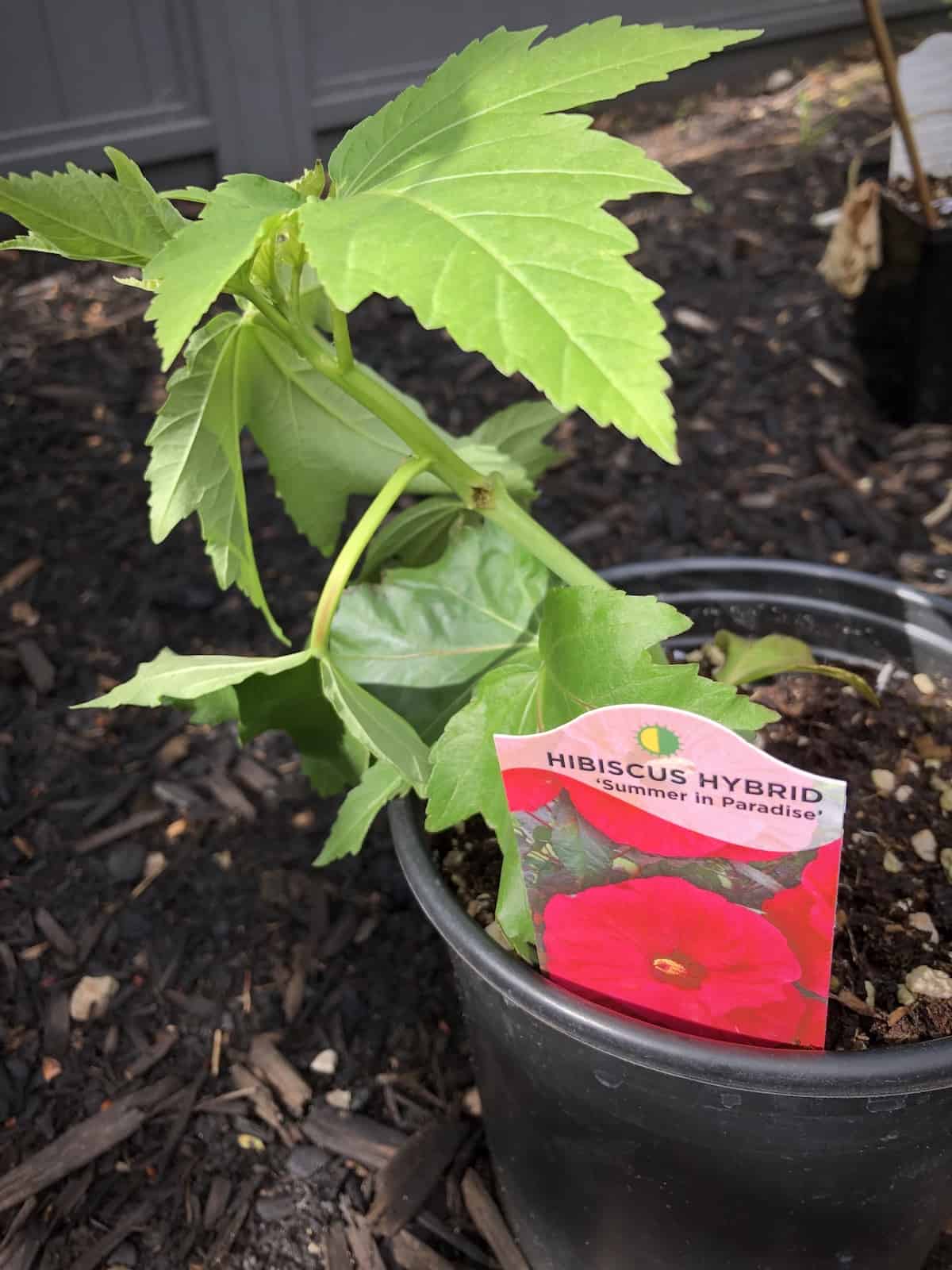
Other dinner plate hibiscus types
- Mars Madness Hibiscus (red)
- Midnight Marvel Hibiscus (red)
- Summer in Paradise (bright pink)
- Airbrush Effect (bright pink)
- Brandy Punch (pink)
- Lady Baltimore (pink)
- Carousel™ Pink Passion (pink)
- Peppermint Schnapps (pink)
- Disco Belle Pink (soft pink)
- Pink Candy (pink and white)
- Southern Belle (pink and white)
- Disco Belle (white and pink)
- Cherry Cheesecake (white and pink)
- Mocha Moon (white and pink)
- Disco Belle White (white)
- Dark Mystery (white)
- Blue River II (white)
- Lord Baltimore (red)
- Summer Carnival (red)
- Plum Fantasy (red)
- Vintage Wine (red)
- Cherry Brandy (red)
- Fireball (red)
- Fantasia (red)
Hibiscus moscheutos L. (Malvaceae) is native to marshes in the eastern United States from Massachusets to Michagin and south to Albama and Georgia. The horticultural hybrids are variable crosses between Hibiscus moscheutos, H. coccineus, and H. militaris, but are often listed as cultivars of Hibiscus moscheutos (Clausen 1989).
Hibiscus moscheutos Cultivars and Horticultural Hybrids, by Richard G. Hawke, Chicago Botanic Garden

